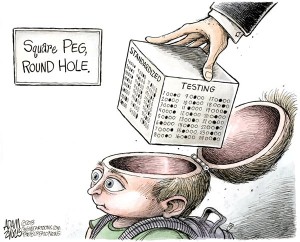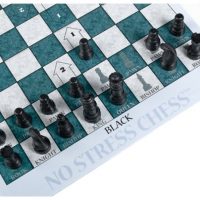 State testing was devised to hold schools, teachers and students accountable for how much the child is learning, achieving and progressing. The tests usually consist of criterion-referenced tests in mathematics, reading, science, and writing. Children are tested on varying subjects on different years. This is the school district’s way of attempting to cut down on the time spent on testing.
State testing was devised to hold schools, teachers and students accountable for how much the child is learning, achieving and progressing. The tests usually consist of criterion-referenced tests in mathematics, reading, science, and writing. Children are tested on varying subjects on different years. This is the school district’s way of attempting to cut down on the time spent on testing.
In the good ole’ days scores were done on a percentile basis reflecting the use of a norm referenced test (NRT) . Parents knew if their child’s score was above the 50th percentile, their child was doing better than average. The NRT informed parents how their child was performing relative to their peer group. A parent could use that information as a barometer to evaluate their child’s performance. Where the child fell on the scale, relative to peers, had implications the parent could take into account.
However, most states are going to a criterion referenced test (CRT) so students are given a score which aligns with their state standards.
There is value in the criteria referenced test (CRT) which is reflected in the above scale. Public education has established a yardstick that reflects their standards of what every student should be able to do by graduation, and therefore preparing them for success in the work world.
The problem occurs when the concept is misused and schools teach the content of the test to produce high scores that do not reflect accurately the child’s mastery of the material. For example, text books in schools are designed with the test questions in mind. At the bottom of a given page you may even see which part of the test is covered by that particular lesson.
It is like telling kids they must learn certain times tables by Friday and then giving them a test on those times tables on Friday. Students can cram for the test on Friday but not remember 8×8 by Sunday.
As a teacher of 16 years, I find the scoring of 1-5 to be a bit of a cop-out because it blends the differences among student performance and denies the parent important information. It is fuzzy math created by people who think it is offensive for parents to know how their child is performing relative to their classmates.
Used properly, a CRT allows you to evaluate your child’s performance in mastering skills and information needed to meet a set of standards. If your child takes a NRT test, like a college entrance exam or an intelligence test, the results will show how your child is doing relative to their peers. Most national exams are NRTs, most state tests are CRTs. Both kinds of information can be important for parents to know.
What are your child’s state scores used for? Schools will use the scores to determine if a child has special needs. High scores may indicate your child is gifted. Very low scores may indicate your child needs remedial help in a subject.
Look for your child’s state test scores at the end May or early June of each year and pay attention to their strengths and weaknesses in the subjects being tested. As a parent, you can monitor your child’s progress by keeping track of how your child is doing relative to the standards set by your state.



